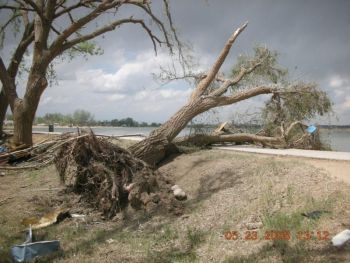Vegetation Management: Difference between revisions
No edit summary |
No edit summary |
||
| (6 intermediate revisions by 3 users not shown) | |||
| Line 1: | Line 1: | ||
__NOTOC__ | __NOTOC__ | ||
[[Category:Operation and Maintenance]] | |||
---- | ---- | ||
{{Picture | {{Picture | ||
| Line 10: | Line 11: | ||
|caption= | |caption= | ||
<!-- Add picture caption --> | <!-- Add picture caption --> | ||
Unwanted or excessive vegetation on an earthen embankment dam may cause significant damage, such as what this uprooted tree has done. ([https://damfailures.org/lessons-learned/uncontrolled-vegetation-on-and-around-dams-can-hinder-inspection-and-lead-to-serious-structural-damage-significant-maintenance-costs-and-possible-failure/ DamFailures.org]) | Unwanted or excessive vegetation on an earthen embankment dam may cause significant damage, such as what this uprooted tree has done. | ||
(Image Source: [https://damfailures.org/lessons-learned/uncontrolled-vegetation-on-and-around-dams-can-hinder-inspection-and-lead-to-serious-structural-damage-significant-maintenance-costs-and-possible-failure/ DamFailures.org]) | |||
}} | }} | ||
“Trees and woody vegetation growth have no place on the embankment of an earthen dam”.<ref name="FEMA P-534">[[Technical Manual for Dam Owners: Impacts of Plants on Earthen Dams (FEMA P-534) | Technical Manual for Dam Owners: Impacts of Plants of Earthen Dams (FEMA P-534), FEMA, 2005]]</ref> | |||
“Most dam safety engineers, including state and federal officials, consultants, and other experts involved with dam safety, agree that when trees and woody plants are allowed to grow on earthen dams, they can hinder safety inspections, can interfere with safe operation, or can even cause dam failure. In the past, engineers and dam safety experts have not always been in agreement about the best way to prevent or control tree growth, remove trees, or repair safety-related damages caused by trees and woody vegetation. However, all dam engineers agree that a healthy, dense stand of low-growing grass on earthen dams is a desirable condition and should be encouraged”.<ref name="FEMA P-534"></ref> | “Most dam safety engineers, including state and federal officials, consultants, and other experts involved with dam safety, agree that when trees and woody plants are allowed to grow on earthen dams, they can hinder safety [[inspections]], can interfere with safe [[operation]], or can even cause dam failure. In the past, engineers and dam safety experts have not always been in agreement about the best way to prevent or control tree growth, remove trees, or repair safety-related damages caused by trees and woody vegetation. However, all dam engineers agree that a healthy, dense stand of low-growing grass on earthen dams is a desirable condition and should be encouraged”.<ref name="FEMA P-534"></ref> | ||
==Examples== | ==Examples== | ||
{{Website Icon}} | {{Website Icon}} [https://damfailures.org/lessons-learned/uncontrolled-vegetation-on-and-around-dams-can-hinder-inspection-and-lead-to-serious-structural-damage-significant-maintenance-costs-and-possible-failure/ Learn more about the dangers of uncontrolled vegetation growth at DamFailures.org] | ||
== | |||
{{Document Icon}} [[Technical Manual for Dam Owners: Impacts of Plants on Earthen Dams (FEMA P-534)|Technical Manual for Dam Owners: Impacts of Plants on Earthen Dams ( | <noautolinks>==Best Practices Resources==</noautolinks> | ||
{{Document Icon}} [[Technical Manual for Dam Owners: Impacts of Plants on Earthen Dams (FEMA P-534) | Technical Manual for Dam Owners: Impacts of Plants on Earthen Dams (FEMA P-534), FEMA]] | |||
==Trainings== | ==Trainings== | ||
{{Video Icon}} [[On-Demand Webinar: Understanding and Managing Plant & Animal Intrusions in Embankment Dams and Levees]] | {{Video Icon}} [[On-Demand Webinar: Understanding and Managing Plant & Animal Intrusions in Embankment Dams and Levees]] | ||
{{Video Icon}} [[On-Demand Webinar: Understanding and Managing Plant and Animal Intrusions in Embankment Dams and Levees – II]] | {{Video Icon}} [[On-Demand Webinar: Understanding and Managing Plant and Animal Intrusions in Embankment Dams and Levees – II]] | ||
</br> | </br> | ||
Citations | |||
{{Citations}} | |||
<!-- Revision history information --> | <!-- Revision history information --> | ||
{{revhistinf}} | {{revhistinf}} | ||
Latest revision as of 20:13, 18 July 2023

|
| Unwanted or excessive vegetation on an earthen embankment dam may cause significant damage, such as what this uprooted tree has done.
(Image Source: DamFailures.org) |
“Trees and woody vegetation growth have no place on the embankment of an earthen dam”.[1]
“Most dam safety engineers, including state and federal officials, consultants, and other experts involved with dam safety, agree that when trees and woody plants are allowed to grow on earthen dams, they can hinder safety inspections, can interfere with safe operation, or can even cause dam failure. In the past, engineers and dam safety experts have not always been in agreement about the best way to prevent or control tree growth, remove trees, or repair safety-related damages caused by trees and woody vegetation. However, all dam engineers agree that a healthy, dense stand of low-growing grass on earthen dams is a desirable condition and should be encouraged”.[1]
Examples
![]() Learn more about the dangers of uncontrolled vegetation growth at DamFailures.org
Learn more about the dangers of uncontrolled vegetation growth at DamFailures.org
Best Practices Resources
![]() Technical Manual for Dam Owners: Impacts of Plants on Earthen Dams (FEMA P-534), FEMA
Technical Manual for Dam Owners: Impacts of Plants on Earthen Dams (FEMA P-534), FEMA
Trainings
Citations:
Revision ID: 7293
Revision Date: 07/18/2023
